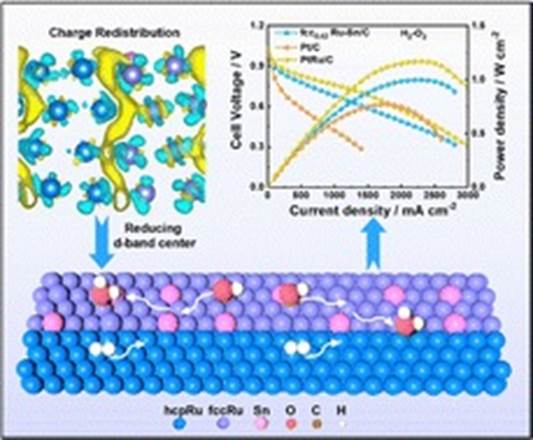Title: Phase and interface engineering of a Ru–Sn nanocatalyst for enhanced alkaline hydrogen oxidation reaction
Authors: Licheng Wei, Wei Yan, Zhongliang Huang, Ruchun Li, Qingyu Kong, Wei-Hsiang Huang, Chih-Wen Pao, Zhiwei Hu, Haixin Lin, Nanjun Chen, Yong Xu*, Hongbo Geng* and Xiaoqing Huang*
Abstract: As the anode reaction of anion exchange membrane fuel cells (AEMFCs), the hydrogen oxidation reaction (HOR) has attracted great attention, however, suffers from low kinetics under alkaline conditions. In this work, we demonstrate that the strong synergy at the heterointerface of hexagonal close-packed (hcp) and face-centered cubic (fcc) phases of Ru–Sn nanoflowers can greatly contribute to acceleration of the alkaline HOR kinetics and strengthen the resistance to CO, a common poison present in industrially produced H2. Experimental observations, in situ characterization, and theoretical calculations suggest that the interfacial synergy, linked to the ratio of the fcc/hcp phase, can modulate the adsorption ability of H, weaken the binding strength to CO, and reduce the energy barrier for CO oxidation. Impressively, the optimal fcc0.42 Ru–Sn/C exhibits a mass activity and specific activity of 4.9 A mgRu−1 and 6.7 mA cmECSA−2 at 50 mV, respectively, which are 9.8 times and 7.4 times higher than those of hcp Ru/C, surpassing those of commercial Pt/C and other recently reported catalysts for the HOR. Moreover, a fuel cell assembled with fcc0.42 Ru–Sn/C exhibits a power peak density (PPD) of 12.46 W mgRu−1.

Full-Link: https://pubs.rsc.org/en/content/articlelanding/2024/ee/d4ee02010c